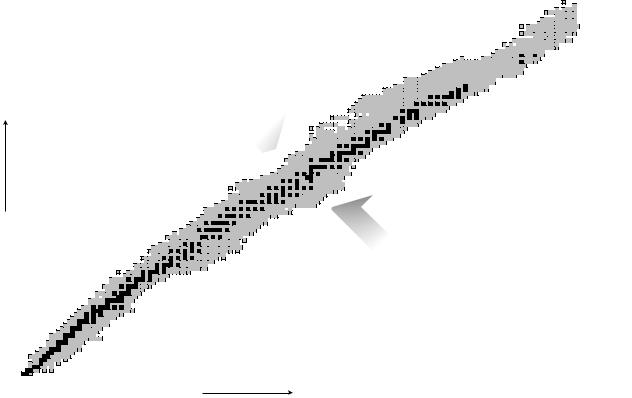
B.Crowell - Electricity and Magnetism, Vol
.4.pdf
Discussion questions
A. In the reactions n → p + e– + ν and p → n + e+ + ν, verify that charge is
conserved. In beta decay, when one of these reactions happens to a neutron or proton within a nucleus, one or more gamma rays may also be emitted. Does this affect conservation of charge? Would it be possible for some extra electrons to be released without violating charge conservation?
B. When an antielectron and an electron annihilate each other, they produce two gamma rays. Is charge conserved in this reaction?
2.7Fusion
As we have seen, heavy nuclei tend to fly apart because each proton is being repelled by every other proton in the nucleus, but is only attracted by its nearest neighbors. The nucleus splits up into two parts, and as soon as those two parts are more than about 1 fm apart, the strong nuclear force no longer causes the two fragments to attract each other. The electrical repulsion then accelerates them, causing them to gain a large amount of kinetic energy. This release of kinetic energy is what powers nuclear reactors and fission bombs.
It might seem, then, that the lightest nuclei would be the most stable, but that is not the case. Let's compare an extremely light nucleus like 4He with a somewhat heavier one, 16O. A neutron or proton in 4He can be attracted by the three others, but in 16O, it might have five or six neighbors attracting it. The 16O nucleus is therefore more stable.
It turns out that the most stable nuclei of all are those around nickel and iron, having about 30 protons and 30 neutrons. Just as a nucleus that is too heavy to be stable can release energy by splitting apart into pieces that are closer to the most stable size, light nuclei can release energy if you stick them together to make bigger nuclei that are closer to the most stable size. Fusing one nucleus with another is called nuclear fusion. Nuclear fusion is what powers our sun and other stars.
This array of gamma-ray detectors, called GAMMASPHERE, is currently housed at Argonne National Laboratory, in Illinois. During operation, the array is closed up, and a beam of ions produced by a particle accelerator strikes a target at its center, producing nuclear fusion reactions. The gamma rays can be studied for information about the structure of the fused nuclei, which are typically varieties not found in nature. The barrel-shaped part behind the scientist is a mass separator used for identifying the type of nucleus formed in the reaction after it recoils out of GAMMASPHERE.
Section 2.7 Fusion |
61 |

2.8 Nuclear Energy and Binding Energies
In the same way that chemical reactions can be classified as exothermic (releasing energy) or endothermic (requiring energy to react), so nuclear reactions may either release or use up energy. The energies involved in nuclear reactions are greater by a huge factor. Thousands of tons of coal would have to be burned to produce as much energy as would be produced in a nuclear power plant by one kg of fuel.
Although nuclear reactions that use up energy (endothermic reactions) can be initiated in accelerators, where one nucleus is rammed into another at high speed, they do not occur in nature, not even in the sun. The amount of kinetic energy required is simply not available.
To find the amount of energy consumed or released in a nuclear reaction, you need to know how much potential energy was stored or released. Experimentalists have determined the amount of potential energy stored in the nucleus of every stable element, as well as many unstable elements. This is the amount of mechanical work that would be required to pull the nucleus apart into its individual neutrons and protons, and is known as the nuclear binding energy.
Example: a reaction occurring in the sun
The sun produces its energy through a series of nuclear fusion reactions. One of the reactions is
1H + 2H → 3He + γ
The excess energy is almost all carried off by the gamma ray (not by the kinetic energy of the helium-3 atom). The binding energies in units of pJ (picojoules) are:
1H |
0 J |
2H |
0.35593 pJ |
3He |
1.23489 pJ |
The total initial potential energy is 0 pJ+0.35593 pJ, and the final potential energy is 1.23489 pJ, so by conservation of energy, the gamma ray must carry off 0.87896 pJ of energy. The gamma ray is then absorbed by the sun and converted to heat.
Self-Check
Why is the binding energy of 1H exactly equal to zero?
The hydrogen-1 nucleus is simply a proton. The binding energy is the energy required to tear a nucleus apart, but for a nucleus this simple there is nothing to tear apart.
62 |
Chapter 2 The Nucleus |

Optional topic: conversion of mass to energy and energy to mass
If you add up the masses of the three particles produced in the reaction n → p + e– +ν , you will find that
they do not equal the mass of the neutron, so mass is not conserved. An even more blatant example is the annihilation of an electron with a positron, e– + e+ → 2γ, in which the original mass is completely destroyed, since gamma rays have no mass. Nonconservation of mass is not just a property of nuclear reactions. It also occurs in chemical reactions, but the change in mass is too small to detect with ordinary laboratory balances.
The reason why mass is not being conserved is that mass is being converted to energy, according to Einstein’s celebrated equation E=mc2, in which c stands for the speed of light. In the reaction e– + e+ → 2γ, for instance, imagine for simplicity that the electron and positron are moving very slowly when they collide, so there is no significant amount of energy to start with. We are starting with mass and no energy, and ending up with two gamma rays that possess energy but no mass. Einstein’s E=mc2 tells us that the conversion factor between mass and energy is equal to the square of the speed of light. Since c is a big number, the amount of energy consumed or released by a chemical reaction only shows up as a tiny change in mass. But in nuclear reactions, which involve large amounts of energy, the change in mass may amount to as much as one part per thousand. Note that in this context, c is not necessarily the speed of any of the particles. We are just using its numerical value as a conversion factor. Note also that E=mc2 does not mean that an object of mass m has a kinetic energy equal to mc2; the energy being described by E=mc2 is the energy you could release if you destroyed the particle and converted its mass entirely into energy, and that energy would be in
addition to any kinetic or potential energy the particle had.
Have we now been cheated out of two perfectly good conservation laws, the laws of conservation of mass and of energy? No, it’s just that according to Einstein, the conserved quantity is E+mc2, not E or m individually. The quantity E+mc2 is referred to as the massenergy, and no violation of the law of conservation of mass-energy has yet been observed. In most practical situations, it is a perfectly reasonable to treat mass and energy as separately conserved quantities.
It is now easy to explain why isolated protons (hydrogen nuclei) are found in nature, but neutrons are only encountered in the interior of a nucleus, not by them-
selves. In the process n → p + e– +ν , the total final
mass is less than the mass of the neutron, so mass is being converted into energy. In the beta decay of a proton, p → n + e+ + ν, the final mass is greater than the initial mass, so some energy needs to be supplied for conversion into mass. A proton sitting by itself in a hydrogen atom cannot decay, since it has no source of energy. Only protons sitting inside nuclei can decay, and only then if the difference in potential energy between the original nucleus and the new nucleus would result in a release of energy. But any isolated neutron that is created in natural or artificial reactions will decay within a matter of seconds, releasing some energy.
The equation E=mc2 occurs naturally as part of Einstein’s theory of special relativity, which is not what we are studying right now. This brief treatment is only meant to clear up the issue of where the mass was going in some of the nuclear reactions we were discussing.
Section 2.8 Nuclear Energy and Binding Energies |
63 |

number of protons
nuclei that undergo alpha decay or fission
nuclei that decay toward the
line of stability by p → n + e+ + ν
nuclei that decay toward the
line of stability by n → p + e– + ν
number of neutrons
The figure above is a compact way of showing the vast variety of the nuclei. Each box represents a particular number of neutrons and protons. The black boxes are nuclei that are stable, i.e. that would require an input of energy in order to change into another. The gray boxes show all the unstable nuclei that have been studied experimentally. Some of these last for billions of years on the average before decaying and are found in nature, but most have much shorter average lifetimes, and can only be created and studied in the laboratory.
The curve along which the stable nuclei lie is called the line of stability. Nuclei along this line have the most stable proportion of neutrons to protons. For light nuclei the most stable mixture is about 50-50, but we can see that stable heavy nuclei have two or three times more neutrons than protons. This is because the electrical repulsions of all the protons in a heavy nucleus add up to a powerful force that would tend to tear it apart. The presence of a large number of neutrons increases the distances among the protons, and also increases the number of attractions due to the strong nuclear force.
64 |
Chapter 2 The Nucleus |

2.9Biological Effects of Ionizing Radiation
As a science educator, I find it frustrating that nowhere in the massive amount of journalism devoted to the Chernobyl disaster does one ever find any numerical statements about the amount of radiation to which people have been exposed. Anyone mentally capable of understanding sports statistics or weather reports ought to be able to understand such measurements, as long as something like the following explanatory text was inserted somewhere in the article:
Radiation exposure is measured in units of millirems. The average person is exposed to about 100 millirems each year from natural background sources.
With this context, people would be able to come to informed conclusions based on statements such as, "Children in Finland received an average dose of ___________ millirems above natural background levels because of the Chernobyl disaster."
A millirem, or mrem, is, of course, a thousandth of a rem, but what is a rem? It measures the amount of energy per kilogram deposited in the body by ionizing radiation, multiplied by a "quality factor" to account for the different health hazards posed by alphas, betas, gammas, neutrons, and other types of radiation. Only ionizing radiation is counted, since nonionizing radiation simply heats one's body rather than killing cells or altering DNA. For instance, alpha particles are typically moving so fast that their kinetic energy is sufficient to ionize thousands of atoms, but it is possible for an alpha particle to be moving so slowly that it would not have enough kinetic energy to ionize even one atom.
Notwithstanding the pop culture images of the Incredible Hulk and Godzilla, it is not possible for a multicellular animal to become “mutated” as a whole. In most cases, a particle of ionizing radiation will not even hit the DNA, and even if it does, it will only affect the DNA of a single cell, not every cell in the animal’s body. Typically, that cell is simply killed, because the DNA becomes unable to function properly. Once in a while, however, the DNA may be altered so as to make that cell cancerous. For instance, skin cancer can be caused by UV light hitting a single skin cell in the body of a sunbather. If that cell becomes cancerous and begins reproducing uncontrollably, she will end up with a tumor twenty years later.
Other than cancer, the only other dramatic effect that can result from altering a single cell’s DNA is if that cell happens to be a sperm or ovum, which can result in nonviable or mutated offspring. Men are relatively immune to reproductive harm from radiation, because their sperm cells are replaced frequently. Women are more vulnerable because they keep the same set of ova as long as they live.
A whole-body exposure of 500,000 mrem will kill a person within a week or so. Luckily, only a small number of humans have ever been exposed to such levels: one scientist working on the Manhattan Project, some victims of the Nagasaki and Hiroshima explosions, and 31 workers at Chernobyl. Death occurs by massive killing of cells, especially in the bloodproducing cells of the bone marrow.
Section 2.9 Biological Effects of Ionizing Radiation |
65 |

Lower levels, on the order of 100,000 mrem, were inflicted on some people at Nagasaki and Hiroshima. No acute symptoms result from this level of exposure, but certain types of cancer are significantly more common among these people. It was originally expected that the radiation would cause many mutations resulting in birth defects, but very few such inherited effects have been observed.
A great deal of time has been spent debating the effects of very low levels of ionizing radiation. A medical x-ray, for instance, may result in a dose on the order of 100 mrem above background, i.e. a doubling of the normal background level. Similar doses in excess of the average background level may be received by people living at high altitudes or people with high concentrations of radon gas in their houses. Unfortunately (or fortunately, depending on how you look at it), the added risks of cancer or birth defects resulting from these levels of exposure are extremely small, and therefore nearly impossible to measure. As with many suspected carcinogenic chemicals, the only practical method of estimating risks is to give laboratory animals doses many orders of magnitude greater, and then assume that the health risk is directly proportional to the dose. Under these assumptions, the added risk posed by a dental x-ray or radon in one's basement is negligible on a personal level, and is only significant in terms of a slight increase in cancer throughout the population. As a matter of social policy, excess radiation exposure is not a significant public health problem compared to car accidents or tobacco smoking.
Discussion questions
A. Should the quality factor for neutrinos be very small, because they mostly
don't interact with your body?
B. Would an alpha source be likely to cause different types of cancer depending on whether the source was external to the body or swallowed in contaminated food? What about a gamma source?
66 |
Chapter 2 The Nucleus |

2.10* The Creation of the Elements
Creation of hydrogen and helium in the Big Bang
We have discussed in book 3 of this series the evidence for the Big Bang theory of the origin of the universe. Did all the chemical elements we’re made of come into being in the Big Bang? The answer is definitely no, since the temperatures in the first microseconds after the Big Bang were so high that atoms and nuclei could not hold together at all. Even after things had cooled down enough for nuclei and atoms to exist, theorists are sure that the only elements created were hydrogen and helium.
We are stardust
In that case, where did all the other elements come from? Astronomers came up with the answer. By studying the combinations of wavelengths of light, called spectra, emitted by various stars, they had been able to determine what kinds of atoms they contained. (We will have more to say about spectra in book 6.) They found that the stars fell into two groups. One type was nearly 100% hydrogen and helium, while the other contained 99% hydrogen and helium and 1% other elements. They interpreted these as two generations of stars. The first generation had formed out of clouds of gas that came fresh from the big bang, and their composition reflected that of the early universe. The nuclear fusion reactions by which they shine have mainly just increased the proportion of helium relative to hydrogen, without making any heavier elements.
The members of the first generation that we see today, however, are only those that lived a long time. Small stars are more miserly with their fuel than large stars, which have short lives. The large stars of the first generation have already finished their lives. Near the end of its lifetime, a star runs out hydrogen fuel and undergoes a series of violent and spectacular reorganizations as it fuses heavier and heavier elements. Very large stars finish this sequence of events by undergoing supernova explosions, in which some of their material is flung off into the void while the rest collapses into an exotic object such as a black hole or neutron star.
The second generation of stars, of which our own sun is an example, condensed out of clouds of gas that had been enriched in heavy elements due to supernova explosions. It is those heavy elements that make up our planet and our bodies.
Section 2.10* The Creation of the Elements |
67 |

Top left: Construction of the UNILAC accelerator in Germany, one of whose uses is for experiments to create very heavy artificial elements.
Top right: This formidable-looking apparatus, called SHIP, is really nothing more than a glorified version of the apparatus used by Thomson to determine the velocity and mass-to-charge ratios of a beam of unknown particles. Nuclei from a beam of ions produced by UNILAC strike a metal foil target, and the nuclei produced in the resulting fusion reaction recoil into ship, which is connected to the “downstream” end of the accelerator. A typical experiment runs for several months, and out of the billions of fusion reactions induced during this time, only one or two may result in the production of superheavy atoms. In all the rest, the fused nucleus breaks up immediately. SHIP is used to identify the small number of “good” reactions and separate them from this intense background.
Artificial synthesis of heavy elements
Elements up to uranium, atomic number 92, were created by these astronomical processes. Beyond that, the increasing electrical repulsion of the protons leads to shorter and shorter half-lives. Even if a supernova a billion years ago did create some quantity of an element such as Berkelium, number 97, there would be none left in the Earth’s crust today. The heaviest elements have all been created by artificial fusion reactions in accelerators. The heaviest element that has been reported in a published scientific paper is 112, but as of 1999 scientists at Berkeley and Dubna have announced the creation of 114 and 118 as well.
Although the creation of a new element, i.e. an atom with a novel number of protons, has historically been considered a glamorous accomplishment, to the nuclear physicist the creation of an atom with a hitherto unobserved number of neutrons is equally important. The greatest neutron number reached so far is 179. One tantalizing goal of this type of research is the theoretical prediction that there might be an island of stability beyond the previously explored tip of the chart of the nuclei shown in section 2.8. Just as certain numbers of electrons lead to the chemical stability of the noble gases (helium, neon, argon, ...), certain numbers of neutrons and protons lead to a particularly stable packing of orbits. Calculations dating back to the 1960’s have hinted that there might be relatively stable nuclei having approximately 114 protons and 184 neutrons. Proton number 114 has been achieved, and indeed displays an amazingly long half-life of 30 seconds. This may not seem like very long, but lifetimes in the microsecond range are more typical for the superheavy elements that have previously been discovered. There is even speculation that certain superheavy elements would be stable enough to be produced in quantities that could for instance be weighed and used in chemical reactions.
68 |
Chapter 2 The Nucleus |

Summary
Selected Vocabulary |
|
|
|
|
alpha particle .......................... |
a form of radioactivity consisting of helium nuclei |
|||
beta particle ............................ |
a form of radioactivity consisting of electrons |
|||
gamma ray .............................. |
a form of radioactivity consisting of a very high-frequency form of light |
|||
proton .................................... |
a positively charged particle, one of the types that nuclei are made of |
|||
neutron .................................. |
an uncharged particle, the other types that nuclei are made of |
|||
isotope.................................... |
one of the possible varieties of atoms of a given element, having a |
|||
|
|
certain number of neutrons |
||
atomic number ....................... |
the number of protons in an atom’s nucleus; determines what element |
|||
|
|
it is |
||
atomic mass ............................ |
the mass of an atom |
|||
mass number .......................... |
the number of protons plus the number of neutrons in a nucleus; |
|||
|
|
approximately proportional to its atomic mass |
||
strong nuclear force ................ |
the force that holds nuclei together against electrical repulsion |
|||
weak nuclear force .................. |
the force responsible for beta decay |
|||
...............................beta decay |
the radioactive decay of a nucleus via the reaction n → p + e– + |
ν |
or |
|
|
|
p → n + e+ + ν; so called because an electron or antielectron is also |
||
|
|
known as a beta particle |
||
alpha decay ............................. |
the radioactive decay of a nucleus via emission of an alpha particle |
|||
fission ..................................... |
the radioactive decay of a nucleus by splitting into two parts |
|||
fusion ..................................... |
a nuclear reaction in which two nuclei stick together to form one |
|||
|
|
bigger nucleus |
||
millirem ................................. |
a unit for measuring a person’s exposure to radioactivity |
|||
Notation |
|
|
|
|
e– ............................................ |
an electron |
|||
e+ ............................................ |
an antielectron; just like an electron, but with positive charge |
|||
n............................................. |
a neutron |
|||
p ............................................. |
a proton |
|||
ν ............................................ |
a neutrino |
|||
ν |
........................................... |
an antineutrino |
||
Notation Used in Other Books |
|
|
|
|
Z ............................................ |
atomic number (number of protons in a nucleus) |
|||
N ............................................ |
number of neutrons in a nucleus |
|||
A ............................................ |
mass number (N+Z) |
|||
Summary
Rutherford and Marsden observed that some alpha particles from a beam striking a thin gold foil came back at angles up to 180 degrees. This could not be explained in the then-favored raisin-cookie model of the atom, and led to the adoption of the planetary model of the atom, in which the electrons orbit a tiny, positivelycharged nucleus. Further experiments showed that the nucleus itself was a cluster of positively-charged protons and uncharged neutrons.
Radioactive nuclei are those that can release energy. The most common types of radioactivity are alpha decay (the emission of a helium nucleus), beta decay (the transformation of a neutron into a proton or viceversa), and gamma decay (the emission of a type of very-high-frequency light). Stars are powered by nuclear fusion reactions, in which two light nuclei collide and form a bigger nucleus, with the release of energy.
Human exposure to ionizing radiation is measured in units of millirem. The typical person is exposed to about 100 mrem worth of natural background radiation per year.
Summary 69

Homework Problems
0.1 nm |
|
|
0.1 nm |
|
|
||||
|
|
|
|
|
electron nucleus electron
Problem 1.
0.1 nm
electron nucleus
0.1 nm
electron
Problem 2.
1 . A helium atom finds itself momentarily in this arrangement. Find the direction and magnitude of the force acting on the right-hand electron. The two protons in the nucleus are so close together (~1 fm) that you can consider them as being right on top of each other.
2 . The helium atom of problem 1 has some new experiences, goes through some life changes, and later on finds itself in the configuration shown here. What are the direction and magnitude of the force acting on the bottom electron? (Draw a sketch to make clear the definition you are using for the angle that gives direction.)
3. Suppose you are holding your hands in front of you, 10 cm apart.
(a ) Estimate the total number of electrons in each hand.
(b ) Estimate the total repulsive force of all the electrons in one hand on all the electrons in the other.
(c)Why don't you feel your hands repelling each other?
(d)Estimate how much the charge of a proton could differ in magnitude from the charge of an electron without creating a noticeable force between your hands.
4 . Suppose that a proton in a lead nucleus wanders out to the surface of the nucleus, and experiences a strong nuclear force of about 8 kN from the nearby neutrons and protons pulling it back in. Compare this numerically to the repulsive electrical force from the other protons, and verify that the net force is attractive. A lead nucleus is very nearly spherical, and is about 6.5 fm in radius.
5 . The subatomic particles called muons behave exactly like electrons, except that a muon's mass is greater by a factor of 206.77. Muons are continually bombarding the Earth as part of the stream of particles from space known as cosmic rays. When a muon strikes an atom, it can displace one of its electrons. If the atom happens to be a hydrogen atom, then the muon takes up an orbit that is on the average 206.77 times closer to the proton than the orbit of the ejected electron. How many times greater is the electric force experienced by the muon than that previously felt by the electron?
6 S. The nuclear process of beta decay by electron capture is described parenthetically in section 2.6. The reaction is p+e– ® n+n. (a) Show that charge is conserved in this reaction. (b) Conversion between energy and mass is discussed in an optional topic in section 2.8. Based on these ideas, explain why electron capture doesn’t occur in hydrogen atoms. (If it did, matter wouldn’t exist!)
S |
A solution is given in the back of the book. |
↔ A difficult problem. |
|
A computerized answer check is available. |
ò A problem that requires calculus. |
70 |
Chapter 2 The Nucleus |
